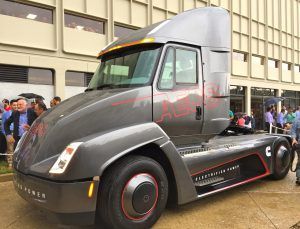Electric vehicles, technology advances surge into trucking industry
by September 4, 2017 6:39 pm 856 views

Big rig trailers might be the solar-powered batteries of the future for factories or warehouses in the supply chain. The trailers, equipped charged batteries, could await an electric tractor and offer it power for a leg of the shipment.
Technologist Rick Mihelic of Mihelic Vehicle Consulting, recently discussed a picture showing the flat roof of a 900,000-square-foot warehouse, surrounded by nearly 165 idle trailers and only one tractor. If 80% of the rooftop was equipped with solar panels, the electricity they would generate could power 60 to 80 electric tractors each moving 100 mile trips. The generated solar power would be stored in batteries in the trailers, and electric big rigs would use that power for its trip.
Shipping lanes could be tailored to the amount of power the trailer batteries have stored. When the tractor reaches its destination, it could pick up another trailer with a fully charged set of batteries, and the process could be repeated.
“It requires rethinking the shipping lanes,” he said.
Mihelic spoke on electric big rigs, advances in technology and how innovation could impact every aspect of the supply chain in the Aug. 30 call hosted by transportation equipment analyst Michael Baudendistel of Stifel. Aspects of the trucking industry that could be impacted by innovation include the driver, the energy source, traffic and congestion, time spent at factories and warehouses and regulations.
“It’s not just the tractor,” Mihelic said.
In 2016, the trucking industry moved 10.42 billion tons of freight, or 70.6% of all domestic freight tonnage, according to trade organization American Trucking Associations. There were 33.8 million trucks registered for commercial use, and 3.68 million of those were class 8 trucks, or the tractors of a tractor-trailer. Mihelic said for every tractor on the road, there are between three and four idle trailers.
The amount of freight hauled per vehicle has risen, while the number of annual miles per truck has fallen. The market has pushed relentlessly to improve efficiency, he said.
On Aug. 30, the U.S. Department of Energy announced PACCAR Inc. would join four other SuperTruck II teams to develop technologies to more than double the freight efficiency of Class 8 trucks, or the tractors of a tractor-trailer. PACCAR will receive up to $8 million for the project, which has awarded a total of $40 million over the past two years. Other companies working on the project include Cummins Inc., Daimler Trucks North America LLC, Navistar Inc. and Volvo Technology of America LLC.

Along with improving freight efficiency by more than 100%, the project aims to improve engine brake thermal efficiency by 55%.
“These trucks haul 80% of goods in the United States and use about 28 billion gallons of fuel per year, accounting for around 22% of total transportation energy usage — presenting a significant opportunity to increase efficiency and reduce cost for a key segment of our nation’s transportation sector,” according to the DOE’s Office of Energy Efficiency & Renewable Energy. “Lowering the trucks’ fuel costs reduces the amount companies need to spend on transportation and can allow retailers to pass that savings on to consumers.”
ELECTRIC BIG RIG
On Aug. 29, Cummins unveiled an all-electric tractor featuring a single, direct-driver motor and battery pack, according to Transport Topics, a publication of American Trucking Associations. The two-axle Aeos tractor includes one 140-kilowatt-per-hour battery pack with a range of 100 miles and weighs as much as a similar-sized diesel-powered tractor.
The truck was designed to include an engine-generator option to improve its range and expected to be 50% more fuel efficient than existing diesel hybrid tractors with zero emissions, according to the article. Cummins will continue to support its customers with conventional diesel, alternative fuels and electric powertrains, and “the introduction of different powertrain technologies will depend on customer demand, applications and market conditions.”
Mihelic said adding technology to vehicles typically means the cost will rise. In the trucking industry, new technology requires a “positive return on investment. In the long run, efficiency gains must materialize.” Some options to pay for new technology includes, reducing driver cost, increase pricing, and increasing vehicle payload and the number of miles per year per vehicle.
In the past, tractors have had a high residual value because they could be reused in secondary markets, allowing for their service life to be between 15 and 30 years. But new tractors are being optimized for their initial use, which limits their life cycle to between three and eight years, he said. Similarly, as technology in phones changed over the past 15 years, the oldest ones have no residual value. While 15-year-old tractor-trailers still operate today, trucks of similar age likely won’t be operating in the future because of the costs.
HYDROGEN POWER
When asked whether future trucks and their shorter life cycle might push smaller carriers out of business, Mihelic said he doesn’t think so because of the option to lease. The Nikola Motor Co. will offer its hydrogen-powered electric tractors with a lease. Owners will be able to trade in for a new truck every seven years.
“Change is inevitable,” he said.
Trains, ships and airplanes are all are larger and capable of hauling more freight than they used to. Advances in technology, such as platooning, will improve fuel efficiency by allowing a truck to follow closely behind another. And, autonomous vehicle technology might one day remove the driver from the cab of a truck. The driver could be sitting in an office and monitoring the road via drone.
But like all changes, they take time for the industry to adapt, and once a technology becomes available it takes years to grow market share. For the foreseeable future, drivers will continue to drive big rigs and diesel engines will be in use for a long time, he said.
